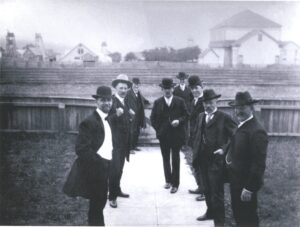Concrete Sidewalks Come to Mendocino
by Karen McGrath and Carol Dominy
This charming photograph, taken by our very own Mendocino photographer, Perley Maxwell, captures a group of friends, family, and neighbors on Christmas Day, 1906.

At the front, the smiling man on the left with beard and bowler is Dr. Frank Peirsol. Behind him stands Henry Jarvis, co-owner of the Jarvis & Nichols general store on the corner of Kasten and Main Streets (Gallery Bookstore today) and also the owner of the fine house on Little Lake Street where this photo is taken.
The older gentleman behind him is Albert Brown, a man of many talents, and who helped bring Mendocino into the age of electricity. Albert lived next door to Jarvis, and the man in the middle is Henry’s neighbor on the west side, C. O. Packard, the Main Street druggist and also associated with the local bank. Packard’s sons are the young fellows in the back, and Dr. William McCornack, whose hospital brought single-pay health care to the area, is in front of them. The man in the right foreground is unknown to us.
We’re looking at this image not so much to identify some of the people who were instrumental in building Mendocino and serving its people, but to bring our attention to what these pillars of the community are standing upon. Concrete.
Indeed, this sidewalk was laid in 1900. As the Mendocino Beacon reported on September 8th, “M. McAvoy, of Navarro, has been in town this week. He is laying a cement sidewalk at H. H. Jarvis’ residence.” Portions of Jarvis’ concrete walk are still there for us to see.
Henry’s wasn’t the first. Scrutinizing historic newspapers, we discover that this honor appears to belong to Hiram Seavey, who in March 1891 put down a new sidewalk in front of his Alhambra Hotel on Main Street. His innovating establishment was also the first in Mendocino to use gas lights (1887) and was supposedly the location of the first telephone.
Walk down Main Street today, in front of Prentice Gallery, and you can see the word BAR stamped into the concrete where the saloon entrance to the now-gone hotel was once located.
Later in 1891, the Beacon reports that Oscar Stone, the jewelry store proprietor, “ever on the alert to improve his property, is laying a cement walk to his residence on Main Street.” Stone owned what we now refer to as the Lansing House, built around 1853, across from the Presbyterian Church.
From its beginning in 1877, William Heeser’s Mendocino Beacon championed building more sidewalks. It declared that they were what made a town civilized, an attractive place to be proud of, one that welcomed visitors and investors, and provided safe passage for its residents off of the streets.
While boardwalks were the easiest and cheapest to construct because of the abundance of wood in a sawmill town, the forward-thinking and always helpful newspaper was also keen on concrete and published, on page one of its December 1877 edition, the correct way to construct “a walk of cement and gravel concrete.”
As the years passed, readers were kept regularly informed of the ever-growing popularity of Portland cement for building foundations, floors for livestock houses, bridges, front steps, and walkways. Even the best houses used it – a page-one story in 1880 describes the extensive use of concrete sidewalks at the huge and lavish Vanderbilt Mansion back east.
Initially developed in 1824 and made in Europe, Portland cement powder was shipped around the world in heavy barrels or jute sacks for mixing on-site (delivered ready-mix concrete wasn’t invented until 1913). Portland cement arrived in the port of nearby San Francisco as early as 1864, but its manufacture on the west coast took a little more time. A large facility was opened near a quarry in Colton, California, and helped supply Los Angeles with 79 miles of concrete sidewalks by 1891.
Back in Mendocino County, we read that the tiny town of Usal, north of Fort Bragg, sported concrete sidewalks in 1896. The new light station at Point Cabrillo was surrounded by them, and Mendocino’s boardwalks were being replaced by knowledgeable contractors advertising their concrete services each week in the paper. By 1906, the Beacon proclaimed that, “Mendocino is about to enter the cement walk era.”
Many of the town’s most community-minded citizens participated in this expansion of safe pedestrian travel. Daisy Kelley MacCallum had concrete walks laid in 1909 along her Ukiah Street properties from Ford Street to Lansing, and then south to Albion Street. John Ross, superintendent of the local lumber mill and leader of many town-building activities, was praised in his 1950 obituary – “It was during his stewardship that the greatest progress was made in the installation of cement sidewalks.”
Today, as we pass by the new concrete walkways around the Savings Bank building on Lansing and Ukiah Streets, we can be confident that this historic paving material was looked upon with favor by the people who built Mendocino.
Check out this link for more information on the past history and more sustainable future of concrete: https://www.bigrentz.com/blog/the-history-of-concrete
For assistance with your historic research questions, please contact Karen McGrath, curator@kelleyhousemuseum.org